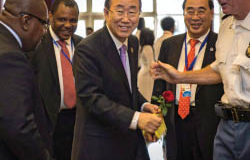“After the Iran deal, the Middle East…

Sam Sasan Shoamanesh
…has been given a rare historic opportunity – one that gives hope to those who long to see the region’s disposition to division and conflict transformed to a culture of multilateralism and peaceful coexistence. That opportunity should not be squandered.
Foreign policy analysis is not an exact science. It would therefore be imprudent to profess to predict with certainty what the Joint Comprehensive Plan of Action will hold for the region. We know what the agreement has achieved to date: it has demonstrated the triumph of diplomacy over hostility and war in managing the crisis over Iran’s nuclear programme. In the process, it has – to a certain degree – thawed Iran-US enmity after more than three decades of seemingly irreconcilable differences. This important development has in turn created a significant opportunity not only for relations between Tehran and Washington, but potentially for the region as a whole.
The jury is still out how the agreement’s various elements will settle in practice and affect the region’s geopolitics. But at this very early stage in the game, there might be two very different ways of interpreting these elements. The first would be to judge the agreement, in isolation, as a strategic gain for Iran alone, and therefore a net loss for the country’s regional rivals. From this zero-sum perspective, the agreement is disruptive to the balance of power and a clear sign of Iranian ascendency and regional influence. The defensive instinct would, as a consequence, be to revert to a default posture involving antagonism, militarization, and the use of proxies to neutralize this enhanced threat, thereby increasing the prospects for further conflict in the region. Early signals suggest that this dynamic is already at play.
To counter this first interpretation of the deal and the anxieties that it engenders, the US, Russia and the other architects of the Iran deal must guard against intensifying the region’s security dilemma through arms sales or outright support for new military adventures. Instead, the general push should be to continue to broker the region’s security arrangements and institutions through multilateralism.
There is a second, preferred interpretation (and course of action) that is open to the region. Instead of seeing threat, Middle Eastern states should view the agreement as a rare chance to alter the region’s conflict-ridden security landscape and address the long list of security issues facing the region in this early new century. In effect, when properly understood, the Iran deal has offered an opening for regional diplomacy, with the major actors at the table, to tackle thorny questions like the Syrian conflict, the rise of ISIS, tensions between Persian Gulf littoral states and, in time, a Middle East that is free of weapons of mass destruction. The adoption of mechanisms and trust-building measures that facilitate conflict resolution through dialogue and common security will be crucial to the sustainability of such efforts. Equally critical will be the support of the UN and, in particular, the P5+1. While fraught with challenges, this is precisely the approach that deserves attention and investment by Middle Eastern states and the international community.
In past writings in GB, I have presented different scenarios for how the Middle East can move toward the establishment of a new regional security order. In the immediate term, the lowest-hanging fruit remains the creation of an annual regional summit for security dialogue among Middle Eastern states. A first such summit should be organized sooner rather than later, and a core agenda must surely be a credible, region-wide response to the threat posed by ISIS.”
» Sam Sasan Shoamanesh is the Senior Special Assistant to the Prosecutor of the International Criminal Court, the Vice-President of the Institute for 21st Century Questions and Managing Editor of Global Brief. The views expressed are the author’s alone.
Thomas Graham Jr.
…has seen the prospects of trade with Iran attracting interest from all four corners. Large German and French business delegations have already visited Tehran. Other European states, including Russia, as well as China, are all looking toward Iran and its relatively uncharted market for business and investment opportunities. This trend will continue unless the agreement is somehow derailed internally in Iran or by the US. American business, too, hopes to trade with Iran, but is holding back for now because of uncertainty in the US.
The nuclear sanctions regime on Iran is history: it will either disappear immediately if the US rejects the agreement and the agreement falls apart as a result, or, if the US does remain a part of the agreement, it will disappear in phases over 10 years, pursuant to the agreement.
The debate has been intense in the US, but this is a sound agreement that is very much in the interest of the US. There is no positive alternative to it, and President Obama has made a strong case that it is this agreement or no agreement. The agreement provides well-defined limits on Iran’s nuclear programme and establishes the basis for a transparency regime that will enable the International Atomic Energy Agency (IAEA) to determine whether Iran’s programme is fully understood and exclusively peaceful.
With a solution to the Iran nuclear issue in force, there will follow a considerable increase in global trade with Iran involving both East and West. It is too early to say what the short- and long-term political effects of the agreement will be in the Middle East and elsewhere. Many differences between Iran and the West will remain, but as a general historical rule, extensive trade ties, including significant tourist exchanges, serve to reduce the risk of military confrontation. And that is an auspicious outcome for not only the signatories of the agreement, but also for Iran’s immediate neighbours and neighbourhood.”
» Thomas Graham Jr., former Acting Director of the US Arms Control and Disarmament Agency and Special Representative of President Clinton for Arms Control, Non-Proliferation, and Disarmament, is the Executive Chairman of the Board at Lightbridge Corporation and the Board Chairman of CanAlaska Uranium Ltd.
Ephraim Kam
…will continue to be unstable.
To be sure, the Iranian nuclear deal includes some positive aspects. The Iranian nuclear programme will be stopped for 10 to 15 years, and some of its components will be rolled back, due to significant restrictions that will be imposed on Tehran’s nuclear activities during this period of time. Iran will be allowed to operate only about half of the centrifuges that it is currently operating. Its present stockpile of enriched uranium – enough for seven or eight bombs, if further enriched – will be reduced from 10,000 kilograms to 300 kilograms. And Iran will not be allowed to enrich uranium at a concentration of 20 percent, or to install advanced centrifuges. The components and purposes of the key nuclear sites in Arak and Fordow will change. These restrictions will make it difficult for Iran to break out to nuclear weapons in a few short weeks, as it may at this time of writing. Moreover, the nuclear programme will be subject to unprecedented supervision for many years.
Nevertheless, these advantages are overshadowed by the negative aspects of the deal. The agreement recognizes Iran as a legitimate nuclear threshold state, leaving in its hands the infrastructure, knowledge and capability to decide whether and when to break out to a bomb. Iran has a long history of hiding and cheating in respect of its nuclear programme, and despite its formal commitment it may well decide to violate the agreement and try to acquire the bomb.
More importantly, most of the restrictions will be lifted after 10 to 15 years. When this happens, Iran will be allowed to build a huge uranium enrichment programme, which will make it far easier for Tehran to identify the optimal timing and to break out to a bomb. Moreover, the verification system, though it includes more intrusive supervision, is fraught with loopholes, which exposes it to cheating from Tehran.
Finally, the removal of the sanctions will provide Iran with significant financial capabilities, which will enable it to advance its nuclear programme, to build up its conventional military capabilities, and to support its allies – including the Assad regime, the Iraqi Shiite militias, Hezbollah and Hamas, as well as its allies in Yemen and Bahrain.”
» Ephraim Kam is a Senior Research Associate at the Institute for National Security Studies in Tel-Aviv. He formerly served as the Deputy Head of the Research Division, IDF Military Intelligence.
Kayhan Barzegar
…may at last find a basis for regional cooperation to battle ISIS, which is increasingly the region’s most important preoccupation.
ISIS emerged and expanded as a result of the political crises in Syria and Iraq, followed by the geopolitical rivalries between regional and trans-regional actors attempting to fill the power vacuum through regime change. The moves of many of these actors – costly in blood and treasure – were mostly aimed at containing Iran’s regional role and growing strategic clout.
The nuclear deal can help to break the conventional yet misplaced view in the West of the necessity of containing Iran as the main source of instability in the region. Likewise, this deal can remove Iran’s sense of insecurity vis-à-vis the US and its regional allies, thereby making Iran more collaborative and accommodating in its regional policy. This development will gradually remove the main justification for continued geopolitical rivalry between the region’s principal actors – Iran, Saudi Arabia and Turkey. Many of the current regional rivalries in Syria and Yemen, and even Iraq – supported by the West – are aimed at restraining Iran’s regional influence. Indeed, the main reason behind the Saudi opposition to the Iran’s nuclear deal and even its bombing of Yemen, or for Turkey taking the side of Saudi Arabia in the Yemeni or Syrian crises, is the containment of Iran.
At present, battling ISIS and establishing security and stability is a common interest and need in the region. However, the aforementioned geopolitical rivalries among the regional actors have led these actors to follow individual, uncoordinated containment policies vis-à-vis ISIS. This approach has proven in practice to not only be ineffective in suppressing ISIS, but has generated a new round of sectarian politics in the region, allowing ISIS to recruit new forces.
Bref, the Iran deal has the potential to shift the calculus of regional states away from extant regional geopolitical rivalries toward the strengthening of collective efforts to solve the existing political crises in Syria and Iraq as the primary requirement for weakening and destroying ISIS.”
» Kayhan Barzegar is the Director of the Institute for Middle East Strategic Studies in Tehran. He is also the Chair of the Department of Political Science and International Relations in the Science and Research Branch of Azad University.








